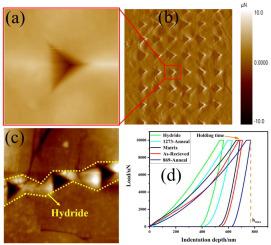International Journal of Refractory Metals & Hard Materials ( IF 4.2 ) Pub Date : 2021-08-05 , DOI: 10.1016/j.ijrmhm.2021.105661 Changxing Cui 1, 2 , Wen Zhang 2 , Feng Wang 2 , Yanchao Li 2, 3 , Benqi Jiao 1, 2 , Jianrong Xue 2 , Mingming Wu 1, 2 , Lian Zhou 1, 2 , Laiping Li 2

|
Microstructure evolution and mechanical properties, i.e., Young's modulus, hardness and yield strength variations were investigated for hydrogenated Zircaloy-4 tubes during thermal decomposition process of precipitated hydrides. Firstly, the embedded δ-hydrides were synthesized through hydrochemical method in autoclave. Then the dehydrogenation temperature and corresponding activation energy were detected via DSC as 832–869 K and 185.4 KJ/mol when heated up to 1273 K which simulated the loss of coolant accident (LOCA) temperature. Finally, nanoindentation technique was performed on samples in as-received state, hydrides, surrounding matrix, post-hydriding samples after 869 and 1273 K anneal to determine the mechanical properties. The Young's modulus and hardness calculation were carried out by Oliver-Pharr theory and corrections were implemented by P-U model meanwhile the yield strength was figured out using empirical equations. The results showed that the modulus, hardness and yield strength of δ-hydrides were the largest of all. Mechanical properties of as-received material were highly similar to the surrounding matrix. Different from 869 K anneal, the microstructure changed from equiaxed grain to Basket-weave Widmanstätten after 1273 K anneal while corresponding modulus, hardness and yield strength elevated to a comparable level with δ-hydrides due to the increase of oxygen content.
中文翻译:

析出δ-氢化物热分解过程中氢化Zircaloy-4管的显微组织和力学性能演变
在沉淀氢化物的热分解过程中,研究了氢化 Zircaloy-4 管的微观结构演变和机械性能,即杨氏模量、硬度和屈服强度变化。首先,在高压釜中通过水化学法合成嵌入的δ-氢化物。然后通过DSC检测到脱氢温度和相应的活化能为832-869 K和185.4 KJ/mol,当加热到1273 K模拟冷却剂损失事故(LOCA)温度时。最后,在 869 和 1273 K 退火后,对处于原样状态的样品、氢化物、周围基质、氢化后样品进行纳米压痕技术,以确定机械性能。年轻人' 模量和硬度计算采用 Oliver-Pharr 理论,PU 模型进行修正,同时使用经验方程计算屈服强度。结果表明,δ-氢化物的模量、硬度和屈服强度最大。原样材料的机械性能与周围基质高度相似。与 869 K 退火不同,1273 K 退火后显微组织由等轴晶转变为篮织 Widmanstätten,同时由于氧含量的增加,相应的模量、硬度和屈服强度提高到与 δ-氢化物相当的水平。原样材料的机械性能与周围基质高度相似。与 869 K 退火不同,1273 K 退火后显微组织由等轴晶转变为篮织 Widmanstätten,同时由于氧含量的增加,相应的模量、硬度和屈服强度提高到与 δ-氢化物相当的水平。原样材料的机械性能与周围基质高度相似。与 869 K 退火不同,1273 K 退火后显微组织由等轴晶转变为篮织 Widmanstätten,同时由于氧含量的增加,相应的模量、硬度和屈服强度提高到与 δ-氢化物相当的水平。











































 京公网安备 11010802027423号
京公网安备 11010802027423号